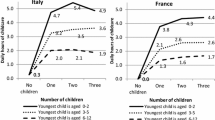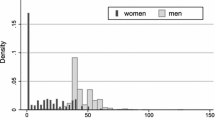Abstract
The important relationship between fertility rates and economic development has prompted many researchers to try and better understand the determinants of family size. It has repeatedly been shown that the costs of children, both direct and indirect, are one of the most important determinants of fertility, exerting a significantly negative effect on birth rates in both developed and developing countries. Many studies which investigate the relationship between the costs of children and family size have assumed that these costs do not vary with parity. However, there is substantial evidence that the marginal costs of children are not constant but decrease with birth order in developed countries. In this paper, the hypothesis that there are diminishing marginal time costs of children is tested using household data from the developing country setting of the Philippines. By examining the determinants of additional time spent in childcare before and after the birth of a child, it is found that the marginal time costs are not the same across households of various sizes. Firstborn children cost significantly more in terms of additional mother's time than children of higher birth orders. In addition, the time costs of the second child are found to be significantly greater than those of the third child. However, these economies of scale in childcare are limited and do not extend beyond three children. The effect of birth spacing on the marginal time costs of children is also found to be significant.
Similar content being viewed by others
References
Becker, G.S. (1960). Economic analysis of fertility, in Demographic and economic change in developed countries. Princeton, NJ: Princeton University Press.
Becker, G.S. (1965). A theory of the allocation of time, Economic Journal 75: 493-517.
Becker, G.S. (1971). A treatise on the family. Cambridge, MA: Harvard University Press.
Becker, G.S. & Lewis, H.G. (1973). On the interaction between the quantity and quality of children, Journal of Political Economy 81(2): S279-S288.
Ben-Porath, Y. (1973). Economic analysis of fertility in Israel: Point and counterpoint, Journal of Political Economy 81(2): S202-S233.
Borg, M.O. (1989). The income-fertility relationship: Effect of the net price of a child, Demography 26(2): 301-310.
Browning, M. (1992). Children and household behavior, Journal of Economic Literature 30(3): 1434-1475.
Buchegger, R. & Zweimuller, J. (1992). Raising children: Private expenditure and foregone earnings, Labour 6(1): 181-120.
Calhoun, C.A. & Espenshade, T.J. (1988). Childbearing and wives' foregone earnings, Population Studies 42: 5-37.
DeTray, D.N. (1973). Child quality and the demand for children, Journal of Political Economy 81(2): S70-S95.
Espenshade, T.J. (1972). The price of children and socio-economic theories of fertility, Population Studies 26(2): 207-221.
Espenshade, T.J. (1973). The cost of children in the urban United States. Berkeley, CA: Population Monograph Series, No. 14.
Espenshade, T.J. (1977). The value and cost of children, Population Bulletin 32(1): 1-47.
Evenson, R. E. (1983). The allocation of women's time: An international comparison, Behavior Science Research 17: 196-215.
Gronau, R. (1976). The allocation of time of Israeli women, Journal of Political Economy 84: S201-S220.
Gronau, R. (1977). Leisure, home production, and work: The theory of the allocation of time revisited, Journal of Political Economy 85: 1099-1123.
Gustafsson, B. & Kjulin, U. (1994). Time use in childcare and housework and the total cost of children, Journal of Population Economics 7(3): 287-306.
Henderson A.M. (1950). The cost of children, Population Studies 4(3): 267-298.
Ho, T. (1979). Time costs of child rearing in the rural Philippines, Population and Development Review 5: 643-662.
Joshi, H. (1990). The cash opportunity costs of childbearing: An approach to estimation using British data, Population Studies 44: 41-60.
Leibowitz, A. (1990). The response of births to changes in health care costs, Journal of Human Resources 25(4): 697-711.
Lindert, P.H. (1978). Fertility and scarcity in America. Princeton, NJ: Princeton University Press.
Lindert, P.H. (1983). The changing economic costs and benefits of having children, in R. Bulatao & R. Lee (eds.), Determinants of fertility in developing countries, Vol. 1, Supply and demand for children. New York: Academic Press.
Nicholson, J.L. (1949). Variations in working-class family expenditure, Journal of the Royal Statistical Society 112(4): 359-411.
Robinson, W.C. (1987). The time cost of children and other household production, Population Studies 41: 313-323.
Turchi, B. (1975). The demand for children: The economics of fertility in the United States. Cambridge, MA: Ballinger Press.
Whittington, L.A. (1992). Taxes and the family: The impact of the tax exemption for dependents on marital fertility, Demography 29(2): 215-226.
Author information
Authors and Affiliations
Rights and permissions
About this article
Cite this article
Holmes, J., Tiefenthaler, J. Cheaper by the dozen? The marginal time costs of children in the Philippines. Population Research and Policy Review 16, 561–578 (1997). https://doi.org/10.1023/A:1005756622764
Issue Date:
DOI: https://doi.org/10.1023/A:1005756622764




